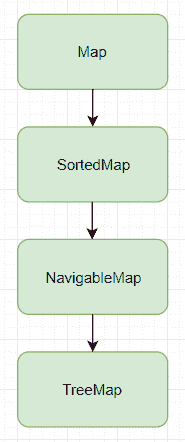# Java `SortedMap`示例
> 原文: [https://javatutorial.net/java-sortedmap-example](https://javatutorial.net/java-sortedmap-example)
`SortedMap`接口擴展了[映射](https://docs.oracle.com/javase/7/docs/api/java/util/Map.html),并確保所有條目都按升序排列(因此,`SortedMap`)。

如果要按降序排列它,則需要重寫`SortedMap`中的`Compare`方法,我們將在稍后進行操作。[`TreeMap`](https://javatutorial.net/java-treemap-example)實現`SortedMap`,并按其自然順序或指定的比較器對鍵進行排序。在[`TreeMap`](https://javatutorial.net/java-treemap-example) 中,不允許使用空鍵和空值。

## 方法摘要
1. `Comparator <? super K> comparator()`:返回用于對當前映射中的鍵進行排序的比較器;如果當前映射使用其鍵的自然順序,則返回`null`。
2. `Set<Map.Entry<K,V>> entrySet()`:返回當前映射中包含的映射的`Set`視圖。
3. `K firstKey()`:返回映射中當前的第一個鍵(最低還是最高,取決于實現映射的方式(升序還是降序)。
4. `SortedMap<K,V> headMap(K toKey)`:返回當前映射中其鍵嚴格小于`toKey`的部分的視圖。
5. `Set<K> keySet()`:返回當前映射中包含的鍵的`Set`視圖
6. `K lastKey()`:返回映射中當前的最后一個(最高或最低)鍵
7. `SortedMap<K,V> subMap(K fromKey, K toKey)`:返回當前映射的部分視圖,其有效范圍從`fromKey`到`toKey`
8. `SortedMap<K,V> tailMap(K fromKey)`:返回當前映射中鍵大于或等于`fromKey`的部分的視圖
9. `Collection <V> values()`:返回當前映射中包含的值的[集合](https://docs.oracle.com/javase/7/docs/api/java/util/Collection.html)視圖
有關這些方法的更多詳細信息,請查閱官方 [Oracle 文檔](https://docs.oracle.com/javase/7/docs/api/java/util/SortedMap.html)。
**代碼實現**
```java
import java.util.*;
public class SortedHashMapExample {
public static void main(String args[]) {
Map<Double, String> players = new TreeMap<Double, String>();
// health, name
players.put(new Double(100.00), "Hill");
players.put(new Double(120.00), "John");
players.put(new Double(150.00), "Sabrina");
players.put(new Double(105.00), "Caitlyn");
players.put(new Double(110.00), "Rachel");
players.put(new Double(130.00), "Michael");
players.put(new Double(140.00), "Mark");
// get a set of the entries
Set setOfEntries = players.entrySet();
// get an iterator
Iterator iterator = setOfEntries.iterator();
while(iterator.hasNext()) {
// create an entry of the map
Map.Entry entry = (Map.Entry)iterator.next();
System.out.println("Key: " + entry.getKey());
System.out.println("Value: " + entry.getValue());
}
}
}
```
**輸出**
```java
Key: 100.0
Value: Hill
Key: 105.0
Value: Caitlyn
Key: 110.0
Value: Rachel
Key: 120.0
Value: John
Key: 130.0
Value: Michael
Key: 140.0
Value: Mark
Key: 150.0
Value: Sabrina
```
如您所見,它將自動按升序對它們進行分組。 它的生命值從 100.00 開始,直到 150.00。 我將健康作為關鍵,并將名稱作為值的原因只是為了向您表明它提升了他們。
但是,如果我們希望按降序排列它們怎么辦?
**使用降序實現**
```java
import java.util.*;
public class SortedHashMapExample {
public static void main(String args[]) {
Map<Double, String> players = new TreeMap<Double, String>(new Comparator<Double>() {
@Override
public int compare(Double x, Double y) {
return y.compareTo(x);
}
});
// name, health
players.put(new Double(100.00), "Hill");
players.put(new Double(120.00), "John");
players.put(new Double(150.00), "Sabrina");
players.put(new Double(105.00), "Caitlyn");
players.put(new Double(110.00), "Rachel");
players.put(new Double(130.00), "Michael");
players.put(new Double(140.00), "Mark");
// get a set of the entries
Set setOfEntries = players.entrySet();
// get an iterator
Iterator iterator = setOfEntries.iterator();
while(iterator.hasNext()) {
// create an entry of the map
Map.Entry entry = (Map.Entry)iterator.next();
System.out.println("Key: " + entry.getKey());
System.out.println("Value: " + entry.getValue());
}
}
}
```
**輸出**
```java
Key: 150.0
Value: Sabrina
Key: 140.0
Value: Mark
Key: 130.0
Value: Michael
Key: 120.0
Value: John
Key: 110.0
Value: Rachel
Key: 105.0
Value: Caitlyn
Key: 100.0
Value: Hill
```
走你,再簡單不過了吧? 我們所做的只是覆蓋比較方法,而不是`x => y`(升序),我們將其更改為`y => x`(降序)。
- JavaTutorialNetwork 中文系列教程
- Java 基礎
- Java 概述
- 在 Ubuntu 上安裝 Java 8 JDK
- Java Eclipse 教程
- Eclipse 快捷方式
- 簡單的 Java 示例
- Java 基本類型
- Java 循環
- Java 數組
- Java 讀取文件示例
- Java 對象和類教程
- 什么是面向對象編程(OOP)
- Java 封裝示例
- Java 接口示例
- Java 繼承示例
- Java 抽象示例
- Java 多態示例
- Java 中的方法重載與方法覆蓋
- Java 控制流語句
- Java 核心
- 如何在 Windows,Linux 和 Mac 上安裝 Maven
- 如何使用 Maven 配置文件
- 如何將自定義庫包含到 Maven 本地存儲庫中
- 如何使用 JUnit 進行單元測試
- 如何使用 Maven 運行 JUnit 測試
- 如何在 Java 中使用 Maven 創建子模塊
- 如何使用 Maven 創建 Java JAR 文件
- 如何使用 Maven 創建 Java WAR 文件
- JVM 解釋
- Java 內存模型解釋示例
- 捕獲 Java 堆轉儲的前 3 種方法
- Java 垃圾收集
- Java 互斥量示例
- Java 信號量示例
- Java 并行流示例
- Java 線程同步
- Java 線程池示例
- Java ThreadLocal示例
- Java 中的活鎖和死鎖
- Java Future示例
- Java equals()方法示例
- Java Lambda 表達式教程
- Java Optional示例
- Java 11 HTTP 客戶端示例
- Java 類加載器介紹
- Java 枚舉示例
- Java hashCode()方法示例
- 如何測試獨立的 Java 應用程序
- SWING JFrame基礎知識,如何創建JFrame
- Java SWING JFrame布局示例
- 在JFrame上顯示文本和圖形
- 與JFrame交互 – 按鈕,監聽器和文本區域
- 如何使用 Maven 創建 Java JAR 文件
- Java Collection新手指南
- 選擇合適的 Java 集合
- Java ArrayList示例
- Java LinkedList示例
- Java HashSet示例
- Java TreeSet示例
- Java LinkedHashSet示例
- Java EnumSet示例
- Java ConcurrentHashSet示例
- Java HashMap示例
- Java LinkedHashMap示例
- Java TreeMap示例
- Java EnumMap示例
- Java WeakHashMap示例
- Java IdentityHashMap示例
- Java SortedMap示例
- Java ConcurrentMap示例
- Java Hashtable示例
- Java 中ArrayList和LinkedList之間的區別
- Java HashMap迭代示例
- Java HashMap內聯初始化
- Java 中HashMap和TreeMap之間的區別
- Java 圖示例
- Java 深度優先搜索示例
- Java 廣度優先搜索示例
- 不同的算法時間復雜度
- Java 序列化示例
- Java 反射示例
- Java 中的弱引用
- Java 8 日期時間 API
- Java 基本正則表達式
- 使用 Java 檢索可用磁盤空間
- Java 生成 MD5 哈希和
- Java 增加內存
- Java 屬性文件示例
- 如何在 Eclipse 上安裝 Java 9 Beta
- Java 9 JShell 示例
- Java 9 不可變列表示例
- Java 9 不可變集示例
- Java 9 不可變映射示例
- Java 單例設計模式示例
- Java 代理設計模式示例
- Java 觀察者設計模式示例
- Java 工廠設計模式
- Java 構建器設計模式
- Java 比較器示例
- Java 發送電子郵件示例
- Java volatile示例
- Java Docker 和 Docker 容器簡介
- 安裝和配置 MySQL 數據庫和服務器以供 Spring 使用
- 如何在 Java 中使用 MySQL 連接器
- 如何使用 Eclipse 調試 Java
- Java EE
- 如何在 Windows 10 中設置JAVA_HOME
- JavaBeans 及其組件簡介
- 如何安裝和配置 Tomcat 8
- 如何在 Tomcat 中部署和取消部署應用程序
- 從 Eclipse 運行 Tomcat
- Java Servlet 示例
- Java Servlet POST 示例
- Servlet 請求信息示例
- Servlet 注解示例
- 使用初始化參數配置 Java Web 應用程序
- Java Servlet 文件上傳
- Java JSP 示例
- Glassfish 啟用安全管理
- 如何使用 MySQL 配置 Glassfish 4
- Java 文件上傳 REST 服務
- Glassfish 和 Jetty 的 Java WebSockets 教程
- 基于 Glassfish 表單的身份驗證示例
- 如何使用 Java EE 和 Angular 構建單頁應用程序
- Spring
- 在 Eclipse 中安裝 Spring STS
- 使用 STS 創建簡單的 Spring Web App
- Spring Web Framework 簡介
- Java Docker 和 Docker 容器簡介
- 在 Spring 中實現控制器
- Spring 中的PathVariable注解
- Spring 中的RequestBody注解
- Spring 中的RequestParam注解
- Spring 攔截器
- Spring IOC
- Java Spring IoC 容器示例
- Spring 中的DispatcherServlet
- Spring 示例中的依賴注入
- 實現 Spring MVC 控制器
- Spring ORM 簡介
- 什么是 DAO 以及如何使用它
- 如何對 DAO 組件進行單元測試
- 如何對控制器和服務執行單元測試
- 安裝和配置 MySQL 數據庫和服務器以供 Spring 使用
- 如何在 Spring 中處理登錄身份驗證
- Spring Security 簡介及其設置
- 如何使用 Spring 創建 RESTful Web 服務
- Spring CSRF 保護
- Spring 中基于 OAuth2 的身份驗證和授權
- Spring Boot 簡介
- Spring MVC 框架介紹
- Spring JDBC 簡介
- 如何 docker 化 Spring 應用程序
- Spring 的@Autowired注解
- Spring AOP 中的核心概念和建議類型
- Sping Bean 簡介
- 如何在 Java 中使用 MySQL 連接器
- 安卓
- 安裝和配置 Android Studio
- 將 Android 設備連接到 Android Studio
- Android 簡介,活動,意圖,服務,布局
- 創建一個簡單的 Android 應用
- 運行和調試 Android 應用程序
- 在虛擬設備上運行 Android 應用程序
- Android 活動示例
- Android 意圖示例
- Android 服務示例
- Android 線性布局示例
- Android 相對布局示例
- Android Web 視圖示例
- Android 列表視圖示例
- Android 網格視圖示例
- 帶有ListAdapter的 Android ListView示例
- Android SQLite 數據庫介紹
- Android SQLite 數據庫示例
- Android 動畫教程
- Android 中的通知
- Android 中的事件處理
- 如何在 Android 中發送帶有附件的電子郵件
- 雜項
- 選擇您的 JAVA IDE:Eclipse,NetBeans 和 IntelliJ IDEA
- Java S3 示例
- 如何在 Ubuntu 上為多個站點配置 Apache
- 如何在 Liferay DXP 中替代現成的(OOTB)模塊
- 簡單的 Git 教程
- 使用 Java 捕獲網絡數據包
- Selenium Java 教程
- 使用特定工作區運行 Eclipse
- 在 Eclipse 中安裝 SVN
- 如何運行 NodeJS 服務器
- SQL 內連接示例
- SQL 左連接示例
- SQL 右連接示例
- SQL 外連接示例
- 樹莓派
- Raspberry Pi 3 規格
- 將 Raspbian 安裝到 SD 卡
- Raspberry Pi 首次啟動
- 遠程連接到 Raspberry Pi
- 建立 Raspberry Pi 遠程桌面連接
- Raspberry Pi Java 教程
- 使用 PWM 的 Raspberry Pi LED 亮度調節
- Raspberry Pi 控制電機速度
- Raspberry Pi 用 Java 控制直流電機的速度和方向
